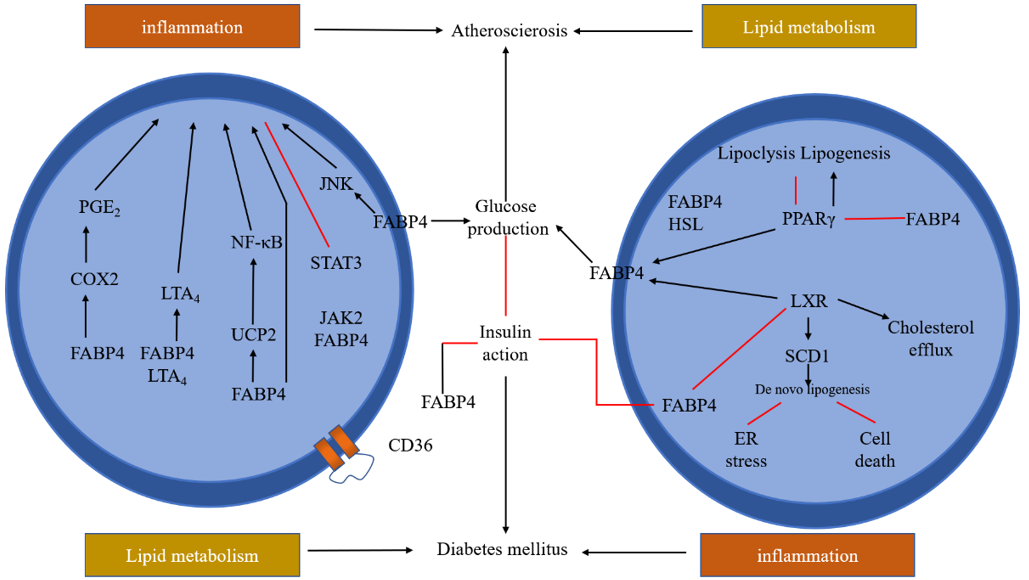
Our promise to you:
Guaranteed product quality, expert customer support.
 24x7 CUSTOMER SERVICE
24x7 CUSTOMER SERVICE
 CONTACT US TO ORDER
CONTACT US TO ORDER
FABP4 Gene Editing 
Fatty acid binding protein 4 (FABP4), also known as adipocyte fatty-acid binding protein (A-FABP), adipocyte P2 (aP2), or adipocyte lipid binding protein (ALBP), is a member of the FABPs family. FABP4 is mainly expressed in adipocytes and macrophages. It has an important regulatory role in energy metabolism and inflammation in the body. It is closely related to glucose and lipid metabolism and insulin resistance. It is considered to be a risk factor for the occurrence and development of T2DM and has become a potential target for treatment T2DM.
Characteristics of FABP4
The FABP4 protein is composed of 2 α helices and 10 β folds. The 10 antiparallel β folds are connected up and down by hydrogen bonds. The first five folds and the last five folds are orthogonal to each other. One end is closed by the protein side chain, and the other end is connected to the alpha helix cap domain to form a ligand binding pocket, which binds fatty acids and other hydrophobic ligands. FABP4 mainly includes four functional regions. Portal region is the portal for ligands to enter and exit; Hinge region is the region where the helix-coil-coil region allows the ligand to enter smoothly through rotation (Glu14, Asn15, Phe16); Charge quartet regulates the interaction between proteins (Asp17, Asp18, Lys21, Arg30); Salt bridge is formed by the ligand and FABP4 cavity amino acid residues Arg106, Arg126 and Tyr128, these amino acid mutations will lead to changes in the properties of the binding ligand.
FABP4 Intracellular Function
FABP4 not only plays a regulatory role by affecting local and circulating free fatty acids, but also directly participates in the regulation of intracellular signaling pathways, such as regulating eicosanoid balance by affecting COX-2 activity, LTA4 stability and up-regulating UCP2 expression. FABP4, as the downstream transcriptional element of PPARγ, can also perform feedback regulation on PPARγ. Fat and macrophage FABP4 specific knockout models indicate that FABP4 negatively regulates PPARγ. FABP4 can also directly interact with HSL, JAK2 and CD36, and regulate the processes until decomposition and transport. Therefore, it can be said that FABP4 plays multiple integrated roles in lipid metabolism and inflammation by regulating fatty acids and their intracellular signals.
 Fig1 FABP4 intracellular function
Fig1 FABP4 intracellular function
FABP4 and Disease
Evidence from clinical and epidemiological studies shows that serum FABP4 concentration is closely related to a variety of diseases, including uppercase syndrome, T2DM, atherosclerosis, fatty liver and cardiovascular disease, and is an important biomolecular marker in serum. Firstly, it was discovered that the diseases with elevated blood FABP4 levels were simple obesity and metabolic syndrome, and then other lipid metabolism disorders such as familial hyperlipidemia and non-alcoholic liver cirrhosis were also found to be elevated in serum FABP4. The weight loss can reduce the serum FABP4 level. In addition, serum FABP4 can be involved in mediating liver glucose production, pancreatic β-cell insulin secretion, macrophage mitochondrial apoptosis, skeletal muscle insulin resistance, endothelial cell function, etc., and may become a predictor of the occurrence, development and accompanying pathological changes of T2DM. It is helpful for the early diagnosis of T2DM and its associated lesions, and has great potential for the treatment of T2DM. It is of great significance to explore the relationship between serum FABP4 and obesity, glucose and lipid metabolism, insulin sensitivity, etc., and to provide new ideas for the diagnosis, prevention and treatment of obesity, T2DM and related metabolic diseases.
FABP4 Gene Editing Services
CRISPR/Cas9 PlatformCB, one of the leading biotechnological companies specializing in gene editing, is dedicated to offering comprehensive CRISPR/Cas9 gene-editing services to a wide range of genomics researchers. Based on our platform, we can help you effectively FABP4 gene deleted, inserted or point mutated in cells or animals by CRISPR/Cas9 technology.
- FABP4 Gene Knockout: We offer FABP4 gene knockout cell line and knockout animal model generation service with high quality. Typically, we develop CRISPR-mediated gene editing cell lines including HEK239T, Hela, HepG2, U87, but we can use other cell lines according to your requirements. Our one-stop KO animal model generation service covers from sgRNA design and construction, pronuclear microinjection to Founders genotyping and breeding.
- FABP4 Gene Knockin: CRISPR/Cas9 PlatformCB provides the one-stop FABP4 knock-in cell line and knockout animal model generation services, including point mutation and gene insertion. Our expert staff has succeeded in dozens of FABP4 knock-in cell line generation projects, including stem cells, tumor cells and even difficult-to-handle cells. We also have extensive experience in incorporating CRISPR/Cas9 technology into animal models, which have been fully recognized by our clients.
If you have any questions, please feel free to contact us.
Related Products at CRISPR/Cas9 PlatformCB
| CATALOG NO. | PRODUCT NAME | PRODUCT TYPE | INQUIRY |
| CCKM0190 | B6J-Fabp4em1Cd | Knockout Mouse | Inquiry |
References
- Hotamisligil, G. S., & Bernlohr, D. A. (2015). 'Metabolic functions of FABPs--mechanisms and therapeutic implications.' Nature reviews. Endocrinology, 11(10), 592–605.
- Roden, M. (2007). 'Blocking fatty acids' mystery tour: a therapy for metabolic syndrome?'. Cell Metabolism, 6(2), 89-91.
- Furuhashi, M., & Hotamisligil, G. S. (2008). 'Furuhashi m, hotamisligil gs.fatty acid-binding proteins: role in metabolic diseases and potential as drug targets.' Nature Reviews Drug Discovery, 7(6), 489-503.